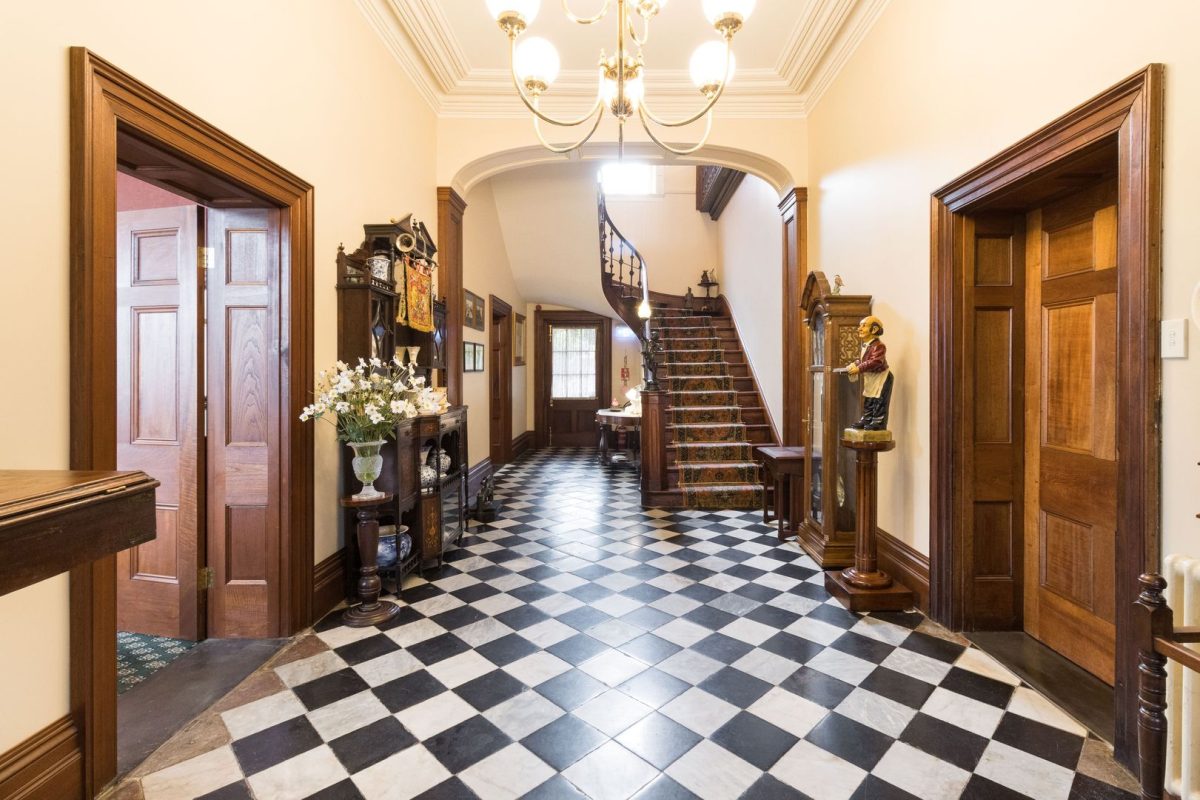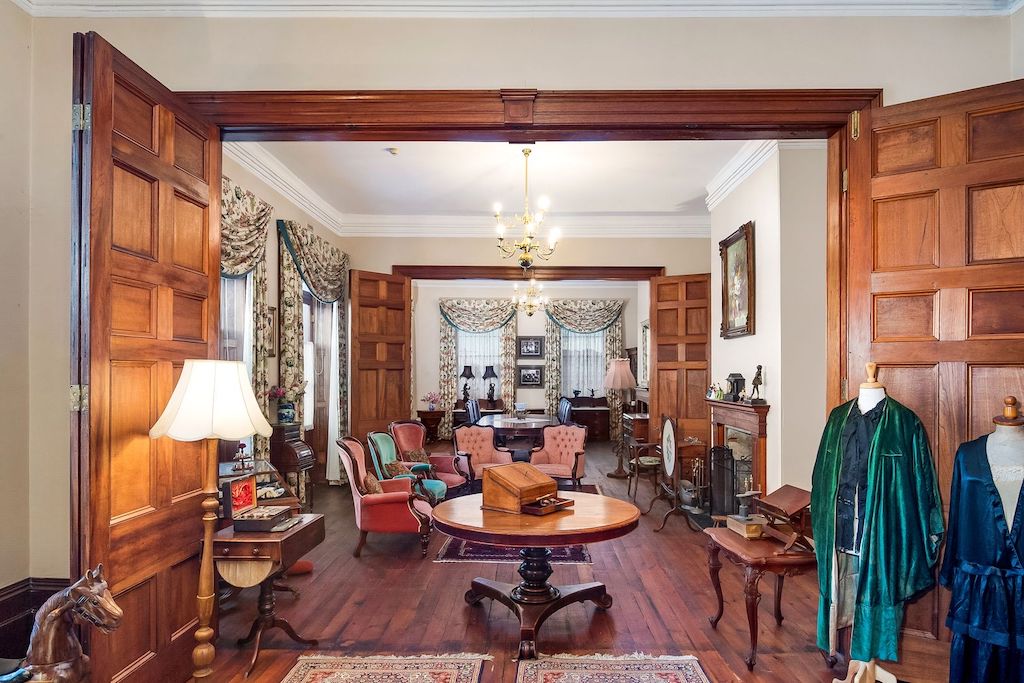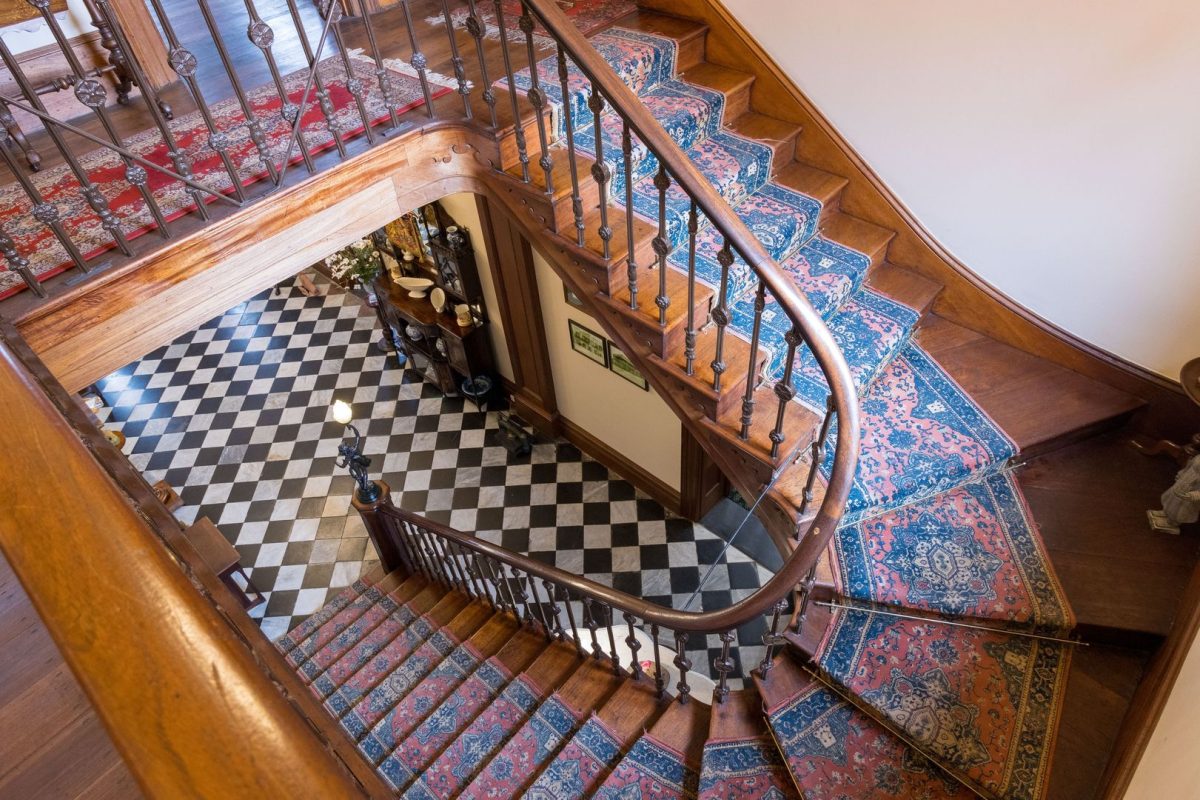
Mandelson’s of Goulburn lobby hall, showing the extensive use of red cedar and the black and white chequerboard tiles. Photo: Supplied by Steve and Claire Ayling.
Its grandeur hidden beneath expedient veneers for years, a private hotel in Goulburn still captivated carpenter and joiner Noel Barrett and his wife Renate in 1999. After buying the once bleak building they researched its history and restored Mandelson’s hotel to its original elegance.
In 2012 the three-storey mansion was sold again to another couple enthralled with its history, Steve and Claire Ayling, who became enthusiastic custodians of its place in the colony’s development. Now it’s on the market again, rekindling that extraordinary restoration.
Noel had refurbished plenty of properties in Sydney, but had never taken on such an ambitious project, and was yet to discover rewarding surprises literally at his fingertips in the 1846 hotel on a corner where Goulburn’s first ever hut was built.
Awaiting planning approvals for their restoration, the couple began stripping out fabric to find most of the original materials in place, including Australian red cedar in all the joinery, skirting boards, architraves and doors.
Lifting the carpet in the foyer revealed locally quarried marble. Then one day while standing outside talking on his phone, Noel flicked loose paint off the wall and noticed an outline of a letter.
“I flicked a bit more and realised what I had discovered,” he said. “I had discovered Deniehy’s sign, which then confirmed he didn’t operate from upstairs (as previously thought), he actually operated from those two rooms on the ground floor. That was a real gem, that was fantastic.”
An early republican, advocate of democracy and Mandelson’s famous tenant, Daniel Deniehy had operated out of an office there, and while his presence in Goulburn has long been celebrated, the actual rooms where he worked had been overlooked.
While finding the sign was like picking low hanging fruit, the restoration was anything but, requiring long hours of research, much expense and energetic elbow grease.

Illawarra red cedar folding doors open to the ballroom that comprises three parlour rooms. The timber is used extensively throughout the house, however the structural timber in the frames including beams in the ceiling was all imported from England. Photo: Supplied by Steve and Claire Ayling.
“We ended up stripping most of the Australian red cedar joinery, stripping the paint off it, bringing it back to its original look,” Noel said. “That was a huge undertaking, involving using a heat gun to get the paint off initially.”
All the wedge-shaped, handmade nails had a fatter head narrowing to a point and once released a little, came out easily, Noel said. “Most of the nails we would pull through the back of the timber so we wouldn’t damage the front.”
Laid on work benches the timber and doors were cleaned down with steel wool. “We took all the mouldings out of the doors, we worked out how to do that without damaging them,” Noel said. “That allowed us to clean the door properly, right into the corners and then we put the moulds back on. It was really a brilliant outcome.”
Durable, lightweight and prized for furniture making and joinery, hardwood Australian red cedar was plundered by early settlers along the coast where it grew to more than 60 metres tall. “We knew nothing about it when we bought the building. We soon learned about it and realised how valuable it was and how important it was to keep it and show it off,” Noel said.
The cantilever staircase and columns in the entry hall also feature Australian cedar. “In these early buildings it was finished with shellack, which is what they would finish furniture with, and shellack with time darkens – the wood looks dark brown, almost black and becomes very unattractive,” Noel said.
Subsequent owners had painted over the shellack, and careful application of a heat gun to avoid burning the wood made it easier to scrape off the shellack and paint.
Repairing the sunrise fanlight windows at the front of the building required moulds as did the lobby and above the staircase. “So we had to make up moulds – more like a template I guess – and you put plaster up there and scrape this mould along to form the particular shape of the moulding,” Noel said.

The cantilever red cedar staircase and handrail and cast-iron balustrades reflect the fine craftsmanship in Mandelson’s and would have been a rare feature at the time of the hotel’s construction says Noel Barrett, who restored it. Photo: Supplied by Steve and Claire Ayling.
Most of the ground level flooring was replaced. As dirt was taken away to allow more ventilation and clearance, Mandelson’s gave up enough coins to fill half a biscuit tin, and a gold sovereign, perhaps a remnant of the owner who also was a gold merchant, or lawyers, governors and eminent businessmen who frequented the hotel in its heyday.
Noting the original owner, hotelier and influential businessman Nathan Mandelson had come from Bungonia east of Goulburn, Steve Ayling said the wheeler and dealer would have been aware of how to get his hands on marble deposits in the area. “Because there wasn’t a grand home or public building that didn’t want to have a black-and-white chequerboard marble entrance hall,” he said.







